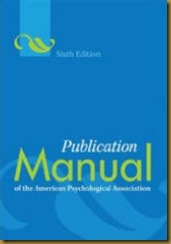 I am writing up my research paper, and in the process am trying to follow the new guidelines in the new Sixth Edition of the Publication Manual of the American Psychological Association (commonly known as APA 6) for the various levels of headings.
I am writing up my research paper, and in the process am trying to follow the new guidelines in the new Sixth Edition of the Publication Manual of the American Psychological Association (commonly known as APA 6) for the various levels of headings.
In my estimation the guidelines in the previous edition (APA 5), were among the most convoluted in the style manual. The previous manual had levels of heading change depending on how levels were used (think Heading 1, Heading 2, etc. in Microsoft Word). Imagine changing the style (look and feel) depending on how many levels were in the paper?! APA 5 did not support the use of bold in headings at all. Very archaic it was . . .
Enter, APA 6. Not only do they now use bold (cf. 3.03, p. 62), and for the sake of consistency, “Regardless of the number of levels of subheading within a section, the heading structure for all sections follows the same top-down progression.” Hey, consistency (especially advocated in a style guide) is a good thing, isn’t it?
Thus, for my paper (which uses only two levels, btw), I now will use headings that have more of a consistent look and feel with what is expected for headings throughout professional literature:
Level 1: Centered, Boldface, Uppercase and Lowercase Heading
Level 2: Flush Left, Boldface, Uppercase and Lowercase Heading
Level 3: Indented, boldface, lowercase paragraph heading ending with a period.
Level 4: Indented, boldface, italicized lowercase paragraph heading ending with a period.
Level 5: Indented, italicized lowercase paragraph heading ending with a period.
One thing to keep in mind—ignore the font examples APA 6 uses as the example, as all this should be done using Times New Roman 12 (cf. 8.03, p. 229)!

 I am nearly finished with my transcription, and as I mentioned
I am nearly finished with my transcription, and as I mentioned